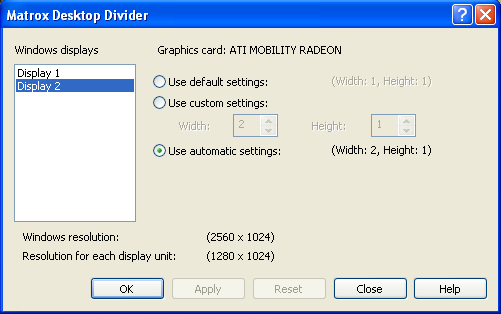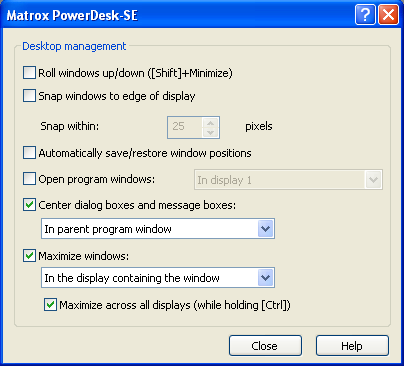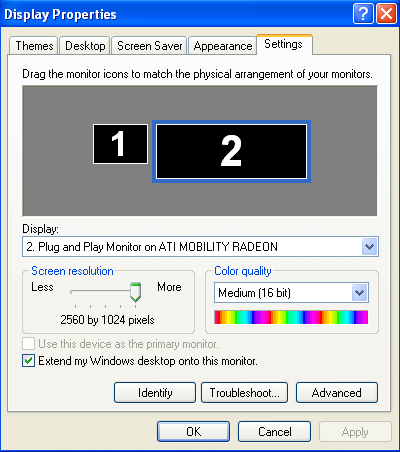The DualHead2Go: External Multi-Display Upgrade from Matrox.
by Josh Venning on November 25, 2005 6:00 AM EST- Posted in
- Displays
The DualHead2Go (cont’d)
Matrox refers to the DualHead2Go on the box as an “External Multi-Display Upgrade for Laptop and PC”, and they provide some visual examples of the usage of their device.
Setting up the drivers and displays to our system was fairly straightforward and we were interested to see how two projection displays would look using the DualHead2Go. These images can give you an idea of what the driver interface looks like.
One thing that we would like to see is a dual link DVI version of the DualHead2Go. Because the connections are all analog, the maximum resolution that you can set is limited to 2560X1024 (depending on your system), but with dual link DVI, you could theoretically get much higher. This might be considered extreme, but given that the device is already very specialized, this would only serve to greatly increase its potential for gaming.
Matrox refers to the DualHead2Go on the box as an “External Multi-Display Upgrade for Laptop and PC”, and they provide some visual examples of the usage of their device.



Setting up the drivers and displays to our system was fairly straightforward and we were interested to see how two projection displays would look using the DualHead2Go. These images can give you an idea of what the driver interface looks like.



One thing that we would like to see is a dual link DVI version of the DualHead2Go. Because the connections are all analog, the maximum resolution that you can set is limited to 2560X1024 (depending on your system), but with dual link DVI, you could theoretically get much higher. This might be considered extreme, but given that the device is already very specialized, this would only serve to greatly increase its potential for gaming.











23 Comments
View All Comments
bigmac - Monday, November 28, 2005 - link
Actually, this is a clever product and it will generate a fair number of sales in Matrox's traditional marketplace -- Trading Desks.Here's the problem: What do you do if you need to add another monitor to your desk?
Answer -- Most often, you're already maxed out on monitors and you end up adding another computer (we're talking 8-12 monitors here, guys!). Then you've got keyboard switching (and short term memory) issues. Sure, you could swap out a box for a bigger one that can handle more displays -- but most desks are on two to three year equipment cycles (an awful lot of desks still use W2K for just this reason).
This new Matrox device provides a simple and elegant solution -- just perform mitosis on one of your existing displays -- double the horizontal resolution -- and move and add windows accordingly.
You gamers ought to get out in the real world and see how people make money with computers instead of spending it on them!
Koing - Monday, November 28, 2005 - link
A lot of guys here are making decent money already.This product is 'purely' for the laptop market imo as far as the gaming idea goes. Guys with a decent enough graphics card to run at least 2048x768 WILL have a dual header already. The projector thing would only be for the laptop as most of the users would have a decent gaming card already.
If the user wanted more space this would be a decent enough product for them.
Koing
Fluppeteer - Tuesday, November 29, 2005 - link
Actually, if anything, the portable use seems least plausible to me(although clearly Matrox think different, and presumably they've
done some market research to prove me wrong.) Actually, I should
qualify that; *moving it* seems least plausible. Using it with
laptops makes sense, although rearranging my desktop so that it
sometimes has lots of pixels and sometimes doesn't would drive
me nuts in short order.
I can see that people wanting a multi-screen setup at work might
want to be able to extract their laptop from it, but I'm not
sure what the point of making it portable would be. Although, on
the other hand, why not? :-) I do think the number of people moving
between desks with two spare screens hanging around not already
attached to a computer they want to use (unless these boxes
proliferate) will be in the minority, unless they're also
carrying the monitors.
Treating it as part of the docking station does make sense, though
- so long as you've only got SXGA screens anyway. The idea clearly
has enough appeal that the VTBook guys can sell their dual output
splitter cables.
For desktop use, I don't really consider it a plain dual-head gaming
solution. I *do* think it's a viable triple or quad-head gaming solution,
or for non-gaming multihead markets. It's also a dual head gaming solution
which would work with SLI, if two LCDs float your boat more than a big CRT.
And it would work for small form factor devices with either half-height
cards. Sadly, for all my claims that anything modern should handle it, I
have to eat humble pie and admit that my EPIA's on board graphics wouldn't...
--
Fluppeteer
Fluppeteer - Monday, November 28, 2005 - link
It does seem to be a cheaper option than Matrox's own QID or the Xentera cards;I'm worried, if anything, that Matrox are poaching their only remaining market!
Only thing is: as someone knowledgeable about trading desks, how much are 17/19"
LCDs still in use? Are people switching up to 20" and larger screens, for which
the DH2Go isn't useful? There's still a price premium to that, of course, but
I see it as a product with a limited shelf life when the market starts seeing
more pixels as a good thing.
I know someone running six Dell 2405FPWs (off one PC) for trading purposes, so
I can independently verify the desire for the desktop space!
We've all been talking about large numbers of heads. Matrox don't seem to support
this, at least directly (from what I read in their support forums, although I
thought I saw something saying this more explicitly, which I now can't find). I
presume the only problem which would arise would be with their Powerdesk software
- can anyone confirm that everything works okay with more than one of these attached?
--
Fluppeteer
roontex - Sunday, November 27, 2005 - link
This will be a big deal for daytraders who need maximum screen space. The price is cheap especially if you are going for > 4 displays.tjr508 - Friday, November 25, 2005 - link
I guess the biggest question here is can this device really improve your screen real-estate. Being my primary monitor uses somewhere between 300-330 MHz of DAC bandwidth at my resolution and refresh rate, this device would be very useless to me. Since we are talking pre-mm display machines here let's say you have a 300MHz bandwidth as opposed to 400 like today. (I think it would be even lower on a lot of systems (laptops for sure)) I thnik it would be quite liberal to suggest an older card could drive two 1024x768 displays @ 85 Hz. This makes desktop usability out of the question since a base cards stard at around $30. And if I am not mistaken, you would need two displays for a laptop instead of the lcd and an external. Hummmmmm. Then again external LCD's dont need to be refreshed as much as CRT's do so you could save some bandwidth there but this is very pointless.
Anandtech didnt want to come right and say it but I will =)
This thing is useless.
Fluppeteer - Monday, November 28, 2005 - link
It's not so useful for decent CRTs - if I wanted two 1024x768 screens, I'd havethrown them away and got a better one which I could drive at 2048x1536. 60Hz
1280x1024 would annoy me on any CRT with any modern phosphor (that said, I'm
running that setup at work out of necessity - and it *does* annoy me). On the other
hand, 60Hz in just fine for all the 17" and 19" LCDs which are so popular right
now. Bit of a shame it's only got the analogue connection, but if you're going for
cheap screens (and haven't just got a 24" instead) then I can see the point in that,
and it avoids the need for dual-link DVI cards for input, for better or for worse.
1280x1024 at 60Hz, according to VESA timings, only needs a pixel clock of 108MHz.
Even doubling that for 2560x1024 is well within the range of pretty much every
plug-in graphics card available in the last 5-10 years; 1024x768 at 85Hz is only
a 94.5MHz clock, and I'm sure cards from longer ago could double that. Laptops and
integrated graphics may be more limited (my older laptops wouldn't cope), but more
modern laptops - capable of 1600x1200 at least - should be fine with it.
More specifically, 1600x1200 at 85Hz needs a faster pixel clock than any of the
stretched modes this device supports. If your spare head can do that, it should
cope. A lot of PCI cards can do that, and relatively few are dual head. Most
cards with any form of dual head capability have some bandwidth headroom - certainly
anything modern does. And you can always go with 16bpp. If this hits the limits of
even the cheapest current PCI cards (other than quad head oddities), I'll be
surprised.
If anything, it's disappointing that this device can't make use of higher pixel
clocks. Modern cards can often double the 1600x1200 60Hz pixel clock (162MHz for
VESA, without reduced blanking), and four 20" LCDs on one device has some appeal.
I'm not sure what your point about needing two screens for a laptop is. That's
the point of this device, no? Whether this disables the internal screen depends
on the laptop.
It may be useless to you, and I can't deny that a DVI version would have more
appeal (but I'm sure that the majority of customers, without dual-link DVI
graphics cards, would rather have analogue support than nothing - at least,
without a reduced refresh version holding a complete frame buffer). It *does*
have a use, though. Four 17" LCDs, two of these, and a decent graphics card are
much cheaper than a 30" Apple Cinema Display with lower resolution; four heads
here are nearly filling my machine (two on an AGP card, one each from two PCIs);
workstation cards are very expensive to buy lots of (and the PCI ones are slow)
to get the same head count; it *is* an option for all but the oldest laptops,
and cheaper (and potentially faster) than a VTBook.
I think their strong point is the proliferation of 17" and 19" TFTs. From that
point of view, I'm not sure the 1024x768 modes are useful, but since the most
common TFT sizes can't use higher resolutions, being able to use more of them
has some appeal. Sure, dual UXGA would be nice, but there's still a premium for
that. I doubt CRT owners will be quite so tempted - either the refresh or the
low resolution will be limiting (although, as I said, I have to admit to having
a 60Hz SXGA CRT on my desk). I'm not sure about laptops, but I can see its
desktop advantages, and laptop alternatives are at least less obvious.
I'm sure it's got a market, although I'm not planning to get one just yet myself.
I'll be more tempted if they make the DVI one I suggested. :-)
I'm not affiliated with Matrox, btw, lest I sound too keen!
--
Fluppeteer
GTMan - Friday, November 25, 2005 - link
I think you are missing the point if you evaluate a product on whether it is useful for everyone. Matrox specializes in niche products particularily for business. So if it is useful in that area then it deserves a thumbs up.The article ended up giving the product a "must have" and a "nice" combined with "price ... to high", "will have even less need for this box" and "impractical". All the negatives are for people the product is not designed for. Should have left those out. People who want the product don't care about an extra two hundred dollars to drive their expensive dual displays.
DerekWilson - Saturday, November 26, 2005 - link
I think we covered the bases pretty well. We pointed out the fact that this is a niche product and that those who have a need for something like this will be well pleased with the functionality.But the need for this product isn't huge. I feel very comfortable saying most of our readers will not need or want something like this. I think it's important to let them know that, while there is a curiosity factor associated with the dh2g and gaming, this isn't a product with universal appeal.
Most people who need one more display than they have would save much money dropping in a PCI graphics card on the desktop side. For notebooks, there isn't really another solution for multidisplay, that limits the market even more. The real advantage of the product is that it offers the possibility of fully accelerated overlay and 3d windows across multiple displays.
But the fact is that people who need something like this won't have another option. And this is a good option for them anyway. For everyone else it isn't really worth it. I don't see how a complete review could leave out either point of view.
g33k - Friday, November 25, 2005 - link
hmm I tried 2560x1024 with AOE3 and your right the seperation in between the monitors is to annoying to be useful. Although the game did not appear to suffer performance wise with a 6800gt. Maybe if I got used to playing with two screens, I wouldn't notice it as much. But yeah one large screen wide screen monitor would be way better. I almost never have to scroll with such a large display.